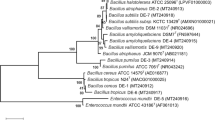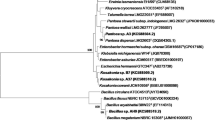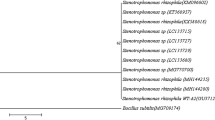Abstract
Phosphate-solubilizing (PS) and phosphate-mineralizing (PM) bacteria are considered vital for augmenting the plant growth through phosphorus mobilization and plant growth-promoting attributes. In the present study, a rhizospheric bacterium was isolated from the virgin land of Punjab, India and identified as ‘Myroides gitamensis’ BSH-3 through 16S rRNA sequencing. ‘M. gitamensis’ showed potential halo zone on Pikovskaya agar. The novelty of the study lies in the fact that plant growth-promoting potential of ‘M. gitamensis’ has not been studied earlier. It was able to solubilize 17.53–106.66 µg/mL of tricalcium phosphate and demonstrated a promising potential of mineralizing sodium phytate corresponding to 44.6–94.70 µg/mL at 28 °C. Variable PS and PM activity was observed at temperature range of 15–42 °C with the maximum activity observed at 28 °C after 96 h of incubation. The nitrogen fixation ability, hydrogen sulfide production, cellulose hydrolysis test and chitin degradation was found to be negative. High indole acetic acid (42.82 µg/mL), gibberellic acid (72.93 µg/mL), ammonia (22.58 µg/mL) production, phytase activity (0.49 pi/mL/min) and comparable amount of siderophore (28.55%) and acid phosphate activity (0.606 µM p-nitrophenol/ml/min) was shown by ‘M. gitamensis’. Inoculation of wheat with ‘M. gitamensis’ in pot experiment showed increased shoot and root length by 30.58% and 38.32%. Fresh weight and dry weight was increased by 45.74% and 67.81%, respectively, compared to uninoculated control. These results demonstrate that ‘M. gitamensis’ has promising PS, PM and plant growth-promoting attributes to be used as a bio-inoculant to enhance plant growth and soil fertility.






Similar content being viewed by others
References
Agbodjato NA, Noumavo PA, Baba-Mouss F, Salami HA, Sina H, Sèzan A, Baba-Mouss L (2015) Characterization of potential plant growth promoting rhizobacteria isolated from Maize (Zea mays L.) in central and Northern Benin (West Africa). Appl Environ Soil Sci 7:1–9
Arora NK, Verma M (2017) Modified microplate method for rapid and efficient estimation of siderophore produced by bacteria. 3 Biotech 7(6):381
Baker AW, Schippers B (1987) Microbial cyanide production in the rhizosphere in relation to potato yield reduction and Pseudomonas sp. mediated plant growth stimulation. Soil Biol Biochem 19:451–457
Baldani JI, Reis VM, Videira SS, Boddey LH, Baldani VLD (2014) The art of isolating nitrogen-fixing bacteria from non-leguminous plants using N-free semi-solid media: a practical guide for microbiologists. Plant Soil 384(1–2):413–431
Behera BC, Yadav H, Singh SK, Mishra RR, Sethi BK, Dutta SK, Thatoi HN (2017) Phosphate solubilization and acid phosphatase activity of Serratia sp. isolated from mangrove soil of Mahanadi river delta Odisha. Ind J Genet Eng Biotechnol 15(1):169–178
Bent E, Tuzun S, Chanway CP, Enebak S (2001) Alterations in plant growth and in root hormone levels of lodgepole pines inoculated with rhizobacteria. Can J Microbiol 47(9):793–800
Borrow A, Brian PW, Chester VE, Curtis PJ, Hemming HG, HenehanC & Radley M, (1955) Gibberellic acid a metabolic product of the fungus Gibberella fujikuroi: some observations on its production and isolation. J Food Agric 6(6):340–348
Bunt JS, Rovira AD (1955) Microbiological studies of some subantartic soils. J Soil Sci 6:119–128
Cappuccino JG, Sherman N (1992) Microbiology; a laboratory manual, 3rd edn. Rockland Community College, Sufern
Chen Q, Liu S (2019) Identification and characterization of the phosphate-solubilizing bacterium Pantoea sp. S32 in Reclamation Soil in Shanxi China. Front microbiol 10:2171
Chen Z, Ma S, Liu LL (2008) Studies on phosphorus solubilizing activity of a strain of phosphobacteria isolated from chestnut type soil in China. Biores technol 99(14):6702–6707
Dorn G, Rivera W (1966) Kinetics of fungal growth and phosphatase formation in Aspergillus nidulans. J Bacteriol 92(6):1618–1622
Dutta J, Thakur D (2017) Evaluation of multifarious plant growth promoting traits antagonistic potential and phylogenetic affiliation of rhizobacteria associated with commercial tea plants grown in Darjeeling India. PLoS ONE 12(8):e0182302
Elhaissoufi W, Khourchi S, Ibnyasser A, Ghoulam C, Rchiad Z, Zeroual Y, Lyamlouli K, Bargaz A (2020) Phosphate Solubilizing Rhizobacteria Could Have a Stronger Influence on Wheat Root Traits and Aboveground Physiology Than Rhizosphere P Solubilization. Front Plant Sci 11:979
Gupta M, Kiran S, Gulati A, Singh B, Tewari R (2012) Isolation and identification of phosphate solubilizing bacteria able to enhance the growth and aloin-A biosynthesis of Aloe barbadensis Miller. Microbiol res 167(6):358–363
Kaur R, Kaur S (2018) Biological alternates to synthetic fertilizers: efficiency and future scopes. Ind J Agric Res 52(6):587–595
Kaur R, Kaur S (2020) Variation in the phosphate solubilizing bacteria from virgin and the agricultural soils of Punjab. Cur Microbiol 77(9):2118–2127
Kerovuo J, Lauraeus M, Nurminen P, Kalkkinen N, Apajalahti J (1998) Isolation, characterization, molecular gene cloning, and sequencing of a novel phytase from Bacillus subtilis. Appl env microbial 64(6):2079–2085
Kim T, Lei XG (2005) An improved method for a rapid determination of phytase activity in animal feed. J Anim Sci 83:1062–1067
Kshetri P, Roy SS, Sharma SK, Singh TS, Ansari MA, Sailo B, Prakash N (2018) Feather degrading phytostimulating and biocontrol potential of native actinobacteria from North Eastern Indian Himalayan Region. J basic microbiol 58(9):730–738
Kutlu HH, Avcı M, Dal T, Arı O, Durmaz R (2020) A healthcare-associated outbreak of urinary tract infections due to Myroidesodoratimimus. Jap J Infect Dis 73(6):421–426
Li Y, Zhang J, Zhang J, Xu W, Mou Z (2019) Characteristics of inorganic phosphate-solubilizing bacteria from the sediments of a eutrophic lake. Int J Environ Res Public Health 16(12):2141
Matos AD, Gomes IC, Nietsche S, Xavier AA, Gomes WS, Santos D, Neto JA, Pereira MC (2017) Phosphate solubilization by endophytic bacteria isolated from banana trees. Anais Acad Brasil Cien 89(4):2945–2954
Mohamed AE, Nessim MG, Ibrahim Abou-el-seoud I, Darwish KM, Shamseldin A (2019) Isolation and selection of highly effective phosphate solubilizing bacterial strains to promote wheat growth in Egyptian calcareous soils. Bull Natl Res Centre 43(1):1–13
Mwakinyali SE, Ming Z, Xie H, Zhan Q, Li P (2019) Investigation and characterization of Myroides odoratimimus strain 3J2MO aflatoxin B1 degradation. J Agric Food Chem 67(16):4595–4602
Numan M, Bashir S, Khan Y, Mumtaz R, Shinwari ZK, Khan AL, Khan A, Ahmed AH (2018) Plant growth promoting bacteria as an alternative strategy for salt tolerance in plants: a review. Microbiolo Res 209:21–32
Oehmen A, Lemos PC, Carvalho G, Yuan Z, Keller J, Blackall LL, Reis MA (2007) Advances in enhanced biological phosphorus removal: from micro to macro scale. Water res 41(11):2271–2300
Olatunji D, Geelen D, Verstraeten I (2017) Control of endogenous auxin levels in plant root development. Int Mol Sci 18(12):2587
Paek J, Shin JH, Shin Y, Park IS, Jin TE, Kook JK, Chang YH (2015) Myroides injenensis sp. nov., a new member isolated from human urine. Antonie Van Leeuwenhoek 107(1):201–207
Pahari A, Mishra BB (2017) Characterization of siderophore producing Rhizobacteria and its effect on growth performance of different vegetables. Int J Curr Microbiol App Sci 6(5):1398–1405
Patel T, Saraf M (2017) Biosynthesis of phytohormones from novel rhizobacterial isolates and their in vitro plant growth-promoting efficacy. J Plant Interact 12(1):480–487
Ram H, Kumar A, Thomas L, Dastager SG, Mawlankar R, Singh VP (2015) Myroides indicus sp. nov isolated from garden soil. Int J Syst Evol Microbiol 65(11):4008–4012
Rodrigues AA, Forzani MV, Soares RDS, Sibov ST, Vieira JDG (2016) Isolation and selection of plant growth-promoting bacteria associated with sugarcane. Pesquisa Agropecuária Trop 46(2):149–158
Saleemi M, Kiani MZ, Sultan T, Khalid A, Mahmood S (2017) Integrated effect of plant growth-promoting rhizobacteria and phosphate-solubilizing microorganisms on growth of wheat (Triticum aestivum L) under rainfed condition. Agr Food Secur 6(1):1–8
Sarker A, Talukder NM, Islam MT (2014) Phosphate solubilizing bacteria promote growth and enhance nutrient uptake by wheat. Plant Sci Today 1(2):86–93
Sayyed RZ, Badgujar MD, Sonawane HM, Mhaske MM, Chincholkar SB (2005) Production of microbial iron chelators (siderophores) by fluorescent Pseudomonads. Ind J Biotechnol 4(4):484–490
Silva MJ, Junior SF, Kleber Fortes Junior VX, Alves S, Sant’Ana AE. (2020) IAA production of indigenous isolate of plant growth promoting rhizobacteria in the presence of tryptophan. Aust J Crop Sci 14(3):537–544
Singh B, Satyanarayana T (2011) Microbial phytases in phosphorus acquisition and plant growth promotion. Physiol Mol Biol Plant 17(2):93–103
Singh P, Kumar V, Agrawal S (2014) Evaluation of phytase producing bacteria for their plant growth promoting activities. Int J Microbiol 7:1–7
Suleman M, Yasmin S, Rasul M, Yahya M, Atta BM, Mirza MS (2018) Phosphate solubilizing bacteria with glucose dehydrogenase gene for phosphorus uptake and beneficial effects on wheat. PLoS ONE 13(9):e0204408
Swetha S, Padmavathi T (2016) Study of acid phosphatase in solubilization of inorganic phosphates by Piriformospora indica. Pol J Microbiol 65(4):407–412
Szkop M, Bielawski W (2013) A simple method for simultaneous RP-HPLC determination of indolic compounds related to bacterial biosynthesis of indole-3-acetic acid. Antonie Van Leeuwenhoek 103(3):683–691
Talluri VP, Lanka SS, Saladi VR (2019) Statistical optimization of process parameters by Central Composite Design (CCD) for an enhanced production of L-asparaginase by Myroides gitamensis BSH-3 a novel species. Avicenna J medical biotechnol 11(1):59–64
TalluriVssl BM, Siva Kumar K, Anil Kumar P, Rajagopal SV (2014) Myroides gitamensis sp. nov L-asparaginase producing bacteria isolated from slaughter house soil sample in Visakhapatnam. India J Microb Biochem Technol 6:144–147
Tak HI, Ahmad F, Babalola OO, Inam A (2012) Growth, photosynthesis and yield of chickpea as influenced by urban wastewater and different levels of phosphorus. Int Plant Res 2(2):6–13
Tao GC, Tian SJ, Miao-Ying CAI, Guang-Hui XIE (2008) Phosphate-solubilizing and-mineralizing abilities of bacteria isolated from soils. Pedosphere 18(4):515–523
Timmusk S, Behers L, Muthoni J, Muraya A, Aronsson AC (2017) Perspectives and challenges of microbial application for crop improvement. Fron plant sci 9(8):49
Turner BL, Papha´zy MJ, Haygarth PM, McKelvie ID (2002) Inositol phosphates in the environment. Philos Trans R Soc B Biol Sci 357:449–469
Wasaki J, Maruyama H, Tanaka M, Yamamura T, Dateki H, Shinano T, Ito S, Osaki M (2009) Overexpression of the gene for secretory acid phosphatase in white lupin improves the phosphorus uptake and growth of tobacco plants. Soil Sci Plant Nutr 55(1):107–113
Zhang ZD, He LY, Huang Z, Sheng XF (2014) Myroides xuanwuensis sp. nov., a mineral-weathering bacterium isolated from forest soil. Int J Syst Evol Micr 64(2):621–624
Funding
The authors are grateful to the University Grants Commission, New Delhi, India, for awarding the financial assistance to Rajinder Kaur, in the form of Junior Research Fellow under the scheme National Fellowship for OBC students.
Author information
Authors and Affiliations
Contributions
The research proposal was designed by Dr. SK and Ms. RK performed the experimental work and paper writing. Final paper editing and improvement was followed by Dr. SK.
Corresponding author
Ethics declarations
Conflict of interest
The authors declare that they have no financial or non-financial conflict of interest.
Ethics statement
The biosafety test of the bacterial isolate was performed using blood agar. For preparing blood agar, self-blood (2.5 mL) was used with proper care in the presence of a medical practitioner. All the procedures undertaken were in accordance with the ethical standards approved by the Departmental Research Committee and with the 1964 Helsinki Declaration and its later amendments or comparable ethical standards.
Additional information
Communicated by Erko Stackebrandt.
Publisher's Note
Springer Nature remains neutral with regard to jurisdictional claims in published maps and institutional affiliations.
Rights and permissions
About this article
Cite this article
Kaur, R., Kaur, S. Plant growth-promoting potential of ‘Myroides gitamensis’ isolated from virgin soils of Punjab. Arch Microbiol 203, 2551–2561 (2021). https://doi.org/10.1007/s00203-021-02231-8
Received:
Revised:
Accepted:
Published:
Issue Date:
DOI: https://doi.org/10.1007/s00203-021-02231-8




